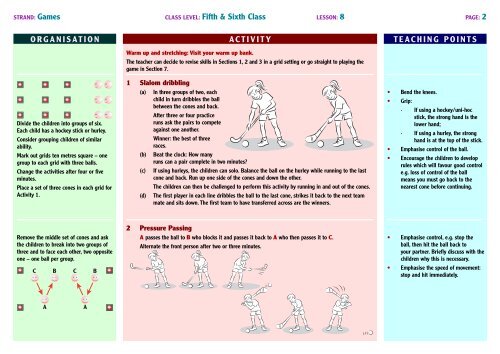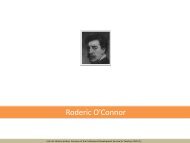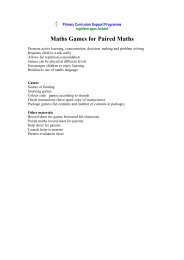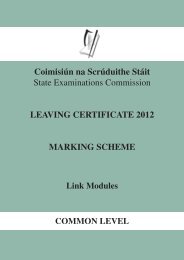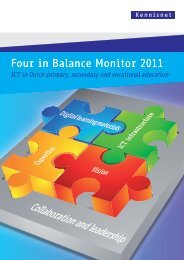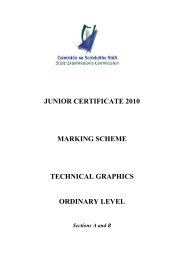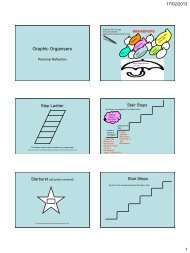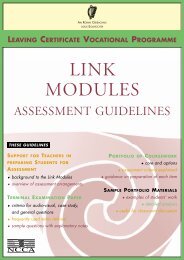Curriculum Objectives Strand Unit: Sending, receiving and ... - PPDS
Curriculum Objectives Strand Unit: Sending, receiving and ... - PPDS
Curriculum Objectives Strand Unit: Sending, receiving and ... - PPDS
Create successful ePaper yourself
Turn your PDF publications into a flip-book with our unique Google optimized e-Paper software.
STRAND: Games CLASS LEVEL: Fifth & Sixth Class LESSON: 8 PAGE: 2<br />
ORGANISATION<br />
Divide the children into groups of six.<br />
Each child has a hockey stick or hurley.<br />
Consider grouping children of similar<br />
ability.<br />
Mark out grids ten metres square – one<br />
group to each grid with three balls.<br />
Change the activities after four or five<br />
minutes.<br />
Place a set of three cones in each grid for<br />
Activity 1.<br />
ACTIVITY<br />
Warm up <strong>and</strong> stretching: Visit your warm up bank.<br />
The teacher can decide to revise skills in Sections 1, 2 <strong>and</strong> 3 in a grid setting or go straight to playing the<br />
game in Section 7.<br />
1 Slalom dribbling<br />
(a)<br />
(b)<br />
(c)<br />
(d)<br />
In three groups of two, each<br />
child in turn dribbles the ball<br />
between the cones <strong>and</strong> back.<br />
After three or four practice<br />
runs ask the pairs to compete<br />
against one another.<br />
Winner: the best of three<br />
races.<br />
Beat the clock: How many<br />
runs can a pair complete in two minutes<br />
If using hurleys, the children can solo. Balance the ball on the hurley while running to the last<br />
cone <strong>and</strong> back. Run up one side of the cones <strong>and</strong> down the other.<br />
The children can then be challenged to perform this activity by running in <strong>and</strong> out of the cones.<br />
The first player in each line dribbles the ball to the last cone, strikes it back to the next team<br />
mate <strong>and</strong> sits down. The first team to have transferred across are the winners.<br />
TEACHING POINTS<br />
• Bend the knees.<br />
• Grip:<br />
· If using a hockey/uni-hoc<br />
stick, the strong h<strong>and</strong> is the<br />
lower h<strong>and</strong>;<br />
· If using a hurley, the strong<br />
h<strong>and</strong> is at the top of the stick.<br />
• Emphasise control of the ball.<br />
• Encourage the children to develop<br />
rules which will favour good control<br />
e.g. loss of control of the ball<br />
means you must go back to the<br />
nearest cone before continuing.<br />
Remove the middle set of cones <strong>and</strong> ask<br />
the children to break into two groups of<br />
three <strong>and</strong> to face each other, two opposite<br />
one – one ball per group.<br />
C<br />
B<br />
C<br />
B<br />
2 Pressure Passing<br />
A passes the ball to B who blocks it <strong>and</strong> passes it back to A who then passes it to C.<br />
Alternate the front person after two or three minutes.<br />
• Emphasise control, e.g. stop the<br />
ball, then hit the ball back to<br />
your partner. Briefly discuss with the<br />
children why this is necessary.<br />
• Emphasise the speed of movement:<br />
stop <strong>and</strong> hit immediately.<br />
A<br />
A


